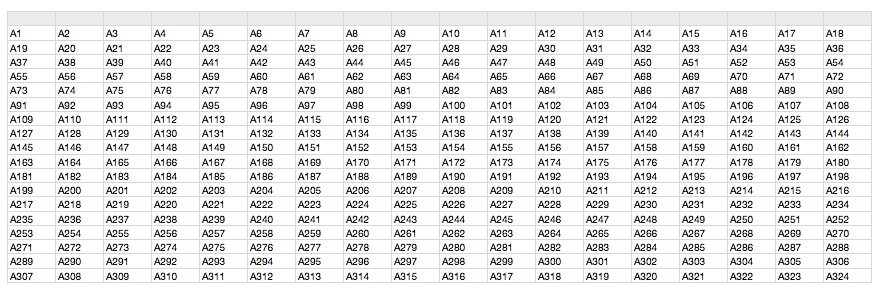What you wrote is not a complete script.
I added some of the missing instructions and it became :
--{code}
my writeToSpreadsheet({"A1", "A2", "A3", "A4", "A5", "A6", "A7", "A8", "A9", "A10", "A11", "A12", "A13", "A14", "A15", "A16", "A17", "A18"}, 69)
(*
I don't understand what's the need for the i parameter passed to your handler *)
on writeToSpreadsheet(tagValues, i)
tell application "Numbers"
tell table 1 of sheet 1 of document 1
set colDest to 1
set rowDest to 2 --starting on row 2 to allow for header in row 1
(*
noRows isn't used *)
set noRows to 5 --needs to be set by number of selected images in Aperture
repeat while (count column) < 18
add column after last column
end repeat
repeat while (countrow) < (18 + 1) (* +1 required because you leave row 1 empty *)
add row below last row
end repeat
repeat with r from 1 to 18
repeat with c from 1 to 18
set value of cell (rowDest - 1 + r) of column (colDest - 1 + c) to item c of tagValues
end repeat
end repeat
end tell
end tell
end writeToSpreadsheet
--{code}
The result is :

But maybe what you want is what is achieved by this script :
--{code}
my writeToSpreadsheet({"A1", "A2", "A3", "A4", "A5", "A6", "A7", "A8", "A9", "A10", "A11", "A12", "A13", "A14", "A15", "A16", "A17", "A18", "A19", "A20", "A21", "A22", "A23", "A24", "A25", "A26", "A27", "A28", "A29", "A30", "A31", "A32", "A33", "A34", "A35", "A36", "A37", "A38", "A39", "A40", "A41", "A42", "A43", "A44", "A45", "A46", "A47", "A48", "A49", "A50", "A51", "A52", "A53", "A54", "A55", "A56", "A57", "A58", "A59", "A60", "A61", "A62", "A63", "A64", "A65", "A66", "A67", "A68", "A69", "A70", "A71", "A72", "A73", "A74", "A75", "A76", "A77", "A78", "A79", "A80", "A81", "A82", "A83", "A84", "A85", "A86", "A87", "A88", "A89", "A90", "A91", "A92", "A93", "A94", "A95", "A96", "A97", "A98", "A99", "A100", "A101", "A102", "A103", "A104", "A105", "A106", "A107", "A108", "A109", "A110", "A111", "A112", "A113", "A114", "A115", "A116", "A117", "A118", "A119", "A120", "A121", "A122", "A123", "A124", "A125", "A126", "A127", "A128", "A129", "A130", "A131", "A132", "A133", "A134", "A135", "A136", "A137", "A138", "A139", "A140", "A141", "A142", "A143", "A144", "A145", "A146", "A147", "A148", "A149", "A150", "A151", "A152", "A153", "A154", "A155", "A156", "A157", "A158", "A159", "A160", "A161", "A162", "A163", "A164", "A165", "A166", "A167", "A168", "A169", "A170", "A171", "A172", "A173", "A174", "A175", "A176", "A177", "A178", "A179", "A180", "A181", "A182", "A183", "A184", "A185", "A186", "A187", "A188", "A189", "A190", "A191", "A192", "A193", "A194", "A195", "A196", "A197", "A198", "A199", "A200", "A201", "A202", "A203", "A204", "A205", "A206", "A207", "A208", "A209", "A210", "A211", "A212", "A213", "A214", "A215", "A216", "A217", "A218", "A219", "A220", "A221", "A222", "A223", "A224", "A225", "A226", "A227", "A228", "A229", "A230", "A231", "A232", "A233", "A234", "A235", "A236", "A237", "A238", "A239", "A240", "A241", "A242", "A243", "A244", "A245", "A246", "A247", "A248", "A249", "A250", "A251", "A252", "A253", "A254", "A255", "A256", "A257", "A258", "A259", "A260", "A261", "A262", "A263", "A264", "A265", "A266", "A267", "A268", "A269", "A270", "A271", "A272", "A273", "A274", "A275", "A276", "A277", "A278", "A279", "A280", "A281", "A282", "A283", "A284", "A285", "A286", "A287", "A288", "A289", "A290", "A291", "A292", "A293", "A294", "A295", "A296", "A297", "A298", "A299", "A300", "A301", "A302", "A303", "A304", "A305", "A306", "A307", "A308", "A309", "A310", "A311", "A312", "A313", "A314", "A315", "A316", "A317", "A318", "A319", "A320", "A321", "A322", "A323", "A324"}, 69)
(*
I don't understand what's the need for the i parameter passed to your handler *)
on writeToSpreadsheet(tagValues, i)
tell application "Numbers"
tell table 1 of sheet 1 of document 1
set colDest to 1
set rowDest to 2 --starting on row 2 to allow for header in row 1
(*
noRows isn't used *)
set noRows to 5 --needs to be set by number of selected images in Aperture
repeat while (count column) < 18
add column after last column
end repeat
repeat while (countrow) < (18 + 1) (* +1 required because you leave row 1 empty *)
add row below last row
end repeat
repeat with r from 1 to 18
repeat with c from 1 to 18
set value of cell (rowDest - 1 + r) of column (colDest - 1 + c) to item (((r - 1) * 18) + c) of tagValues
end repeat
end repeat
end tell
end tell
end writeToSpreadsheet
--{code}

Yvan KOENIG (VALLAURIS, France) lundi 31 octobre 2011 23:21:05
iMac 21”5, i7, 2.8 GHz, 4 Gbytes, 1 Tbytes, mac OS X 10.6.8 and 10.7.2
My iDisk is : <http://public.me.com/koenigyvan>
Please : Search for questions similar to your own before submitting them to the community